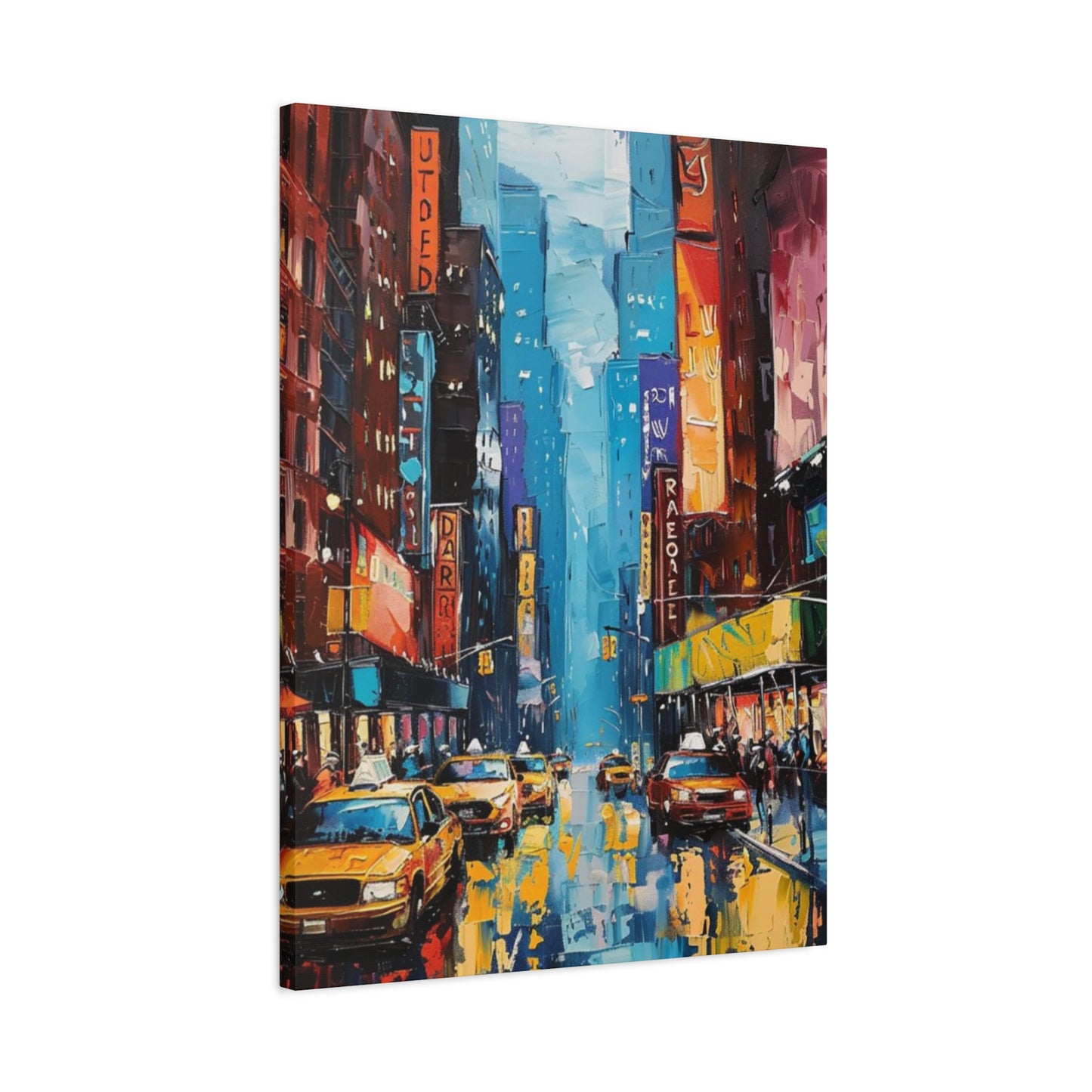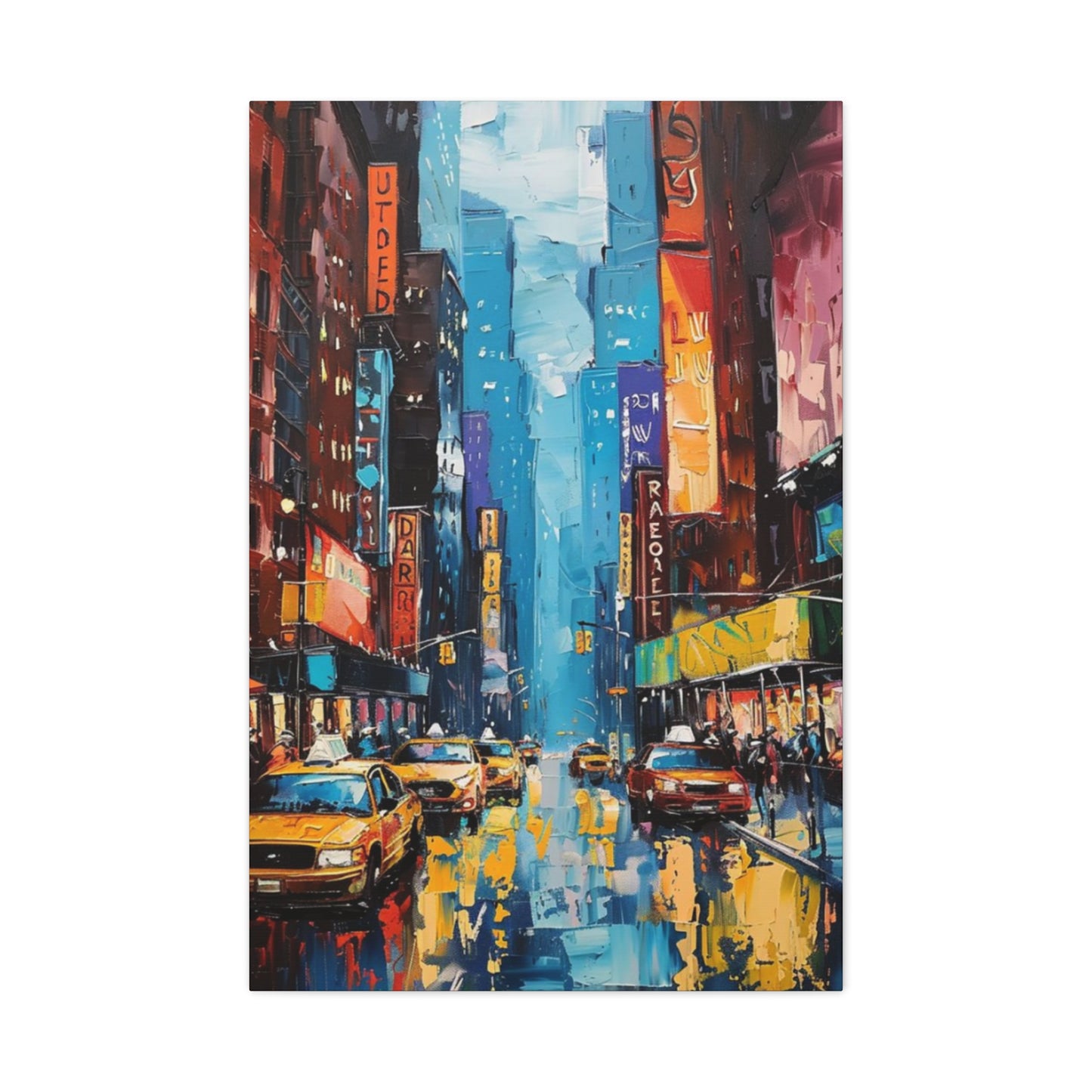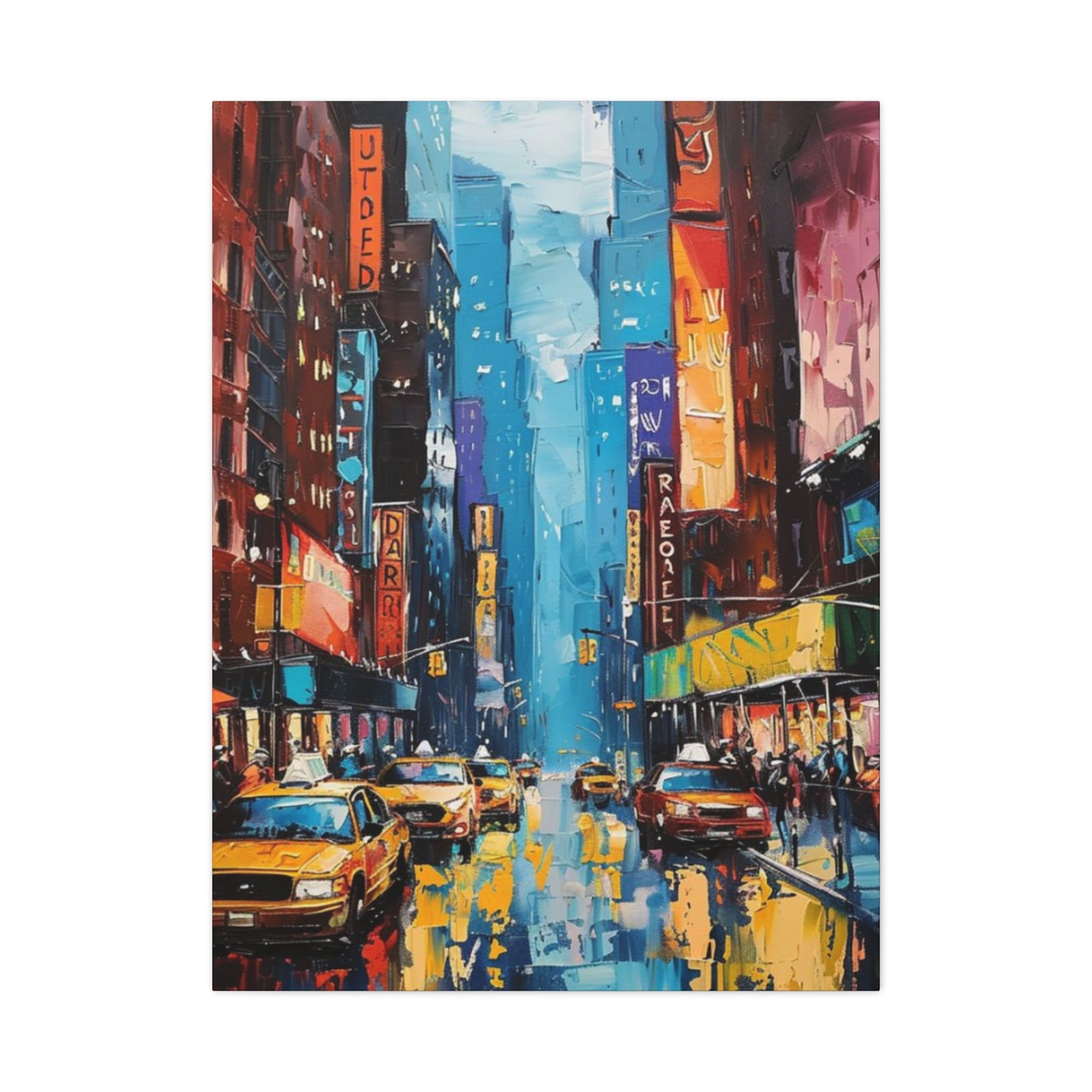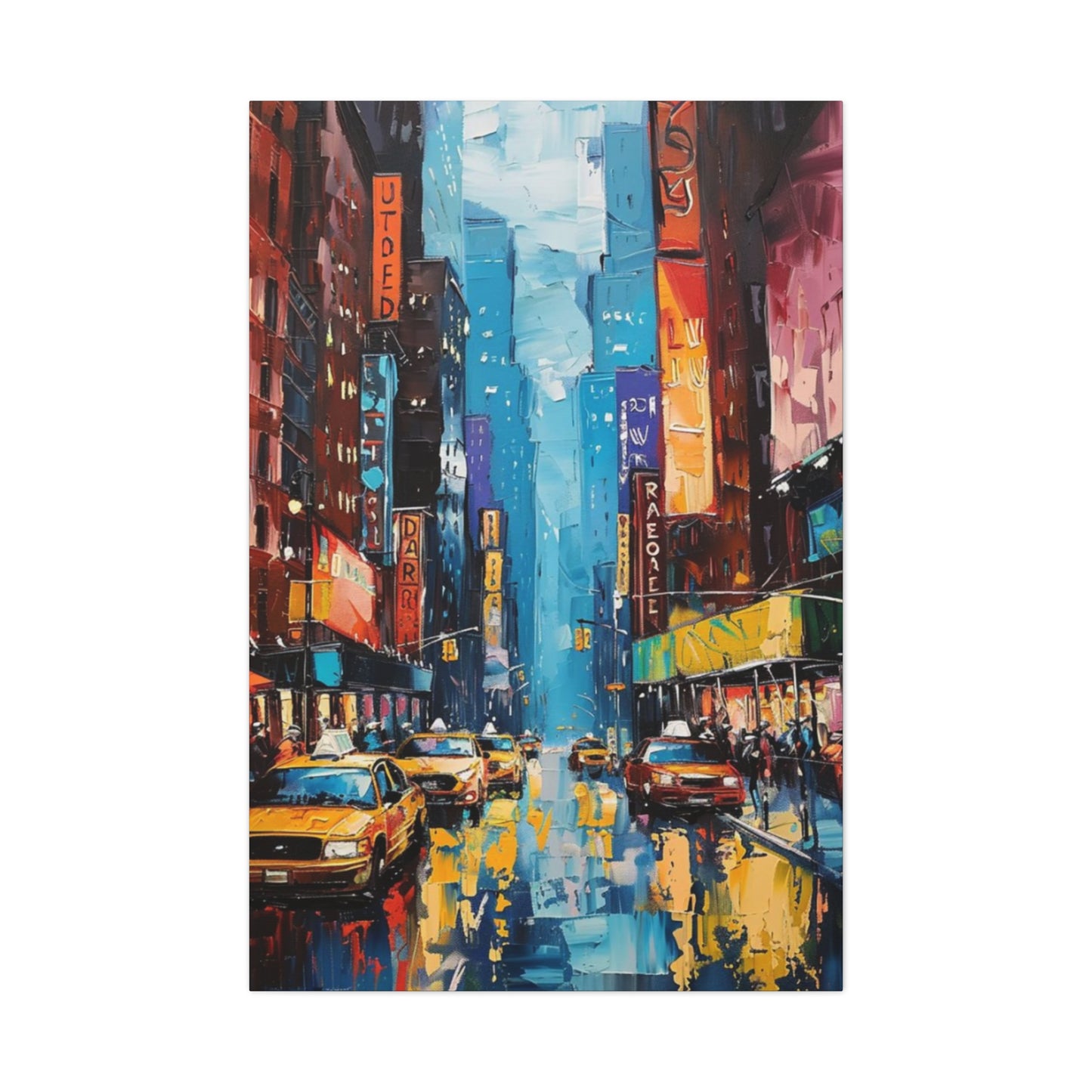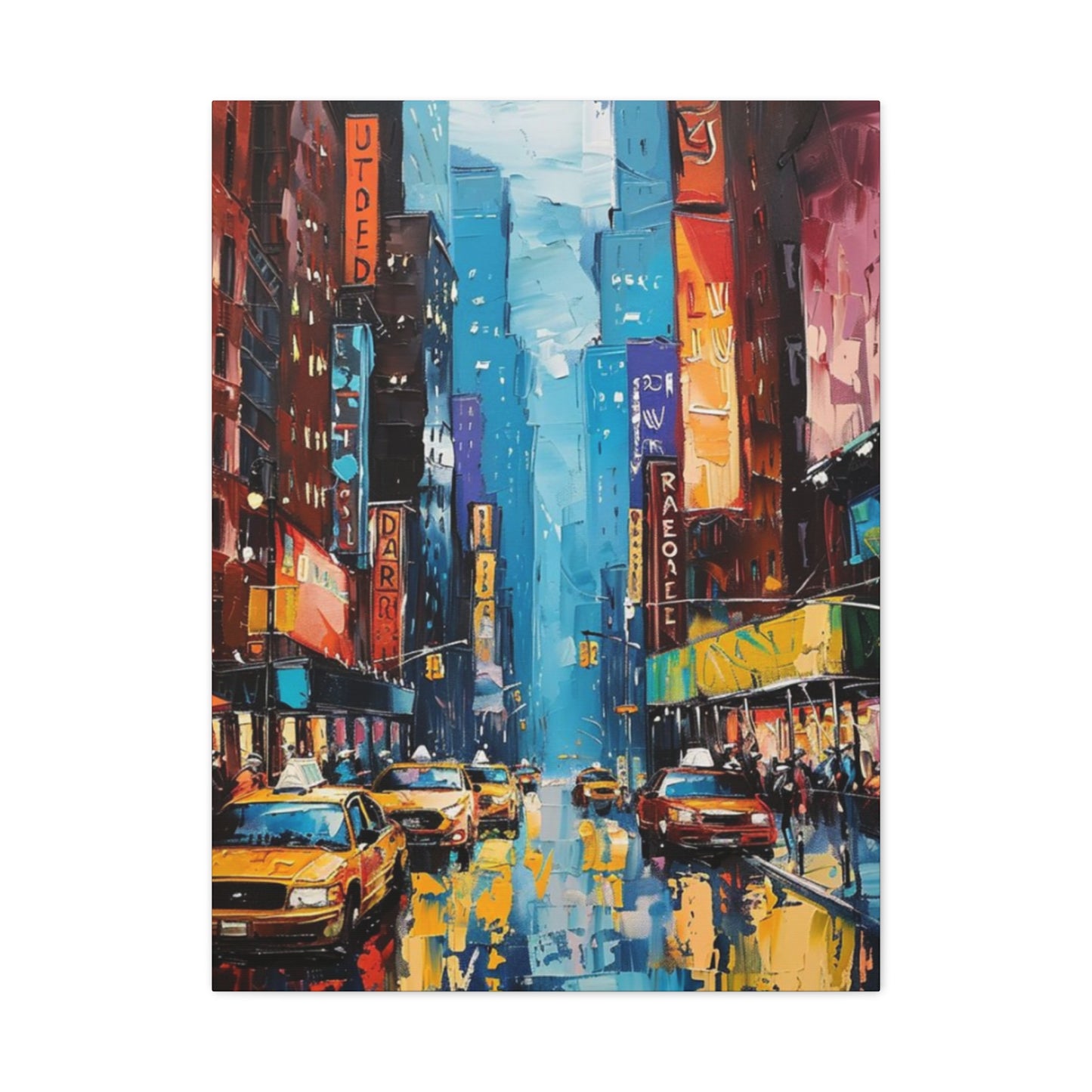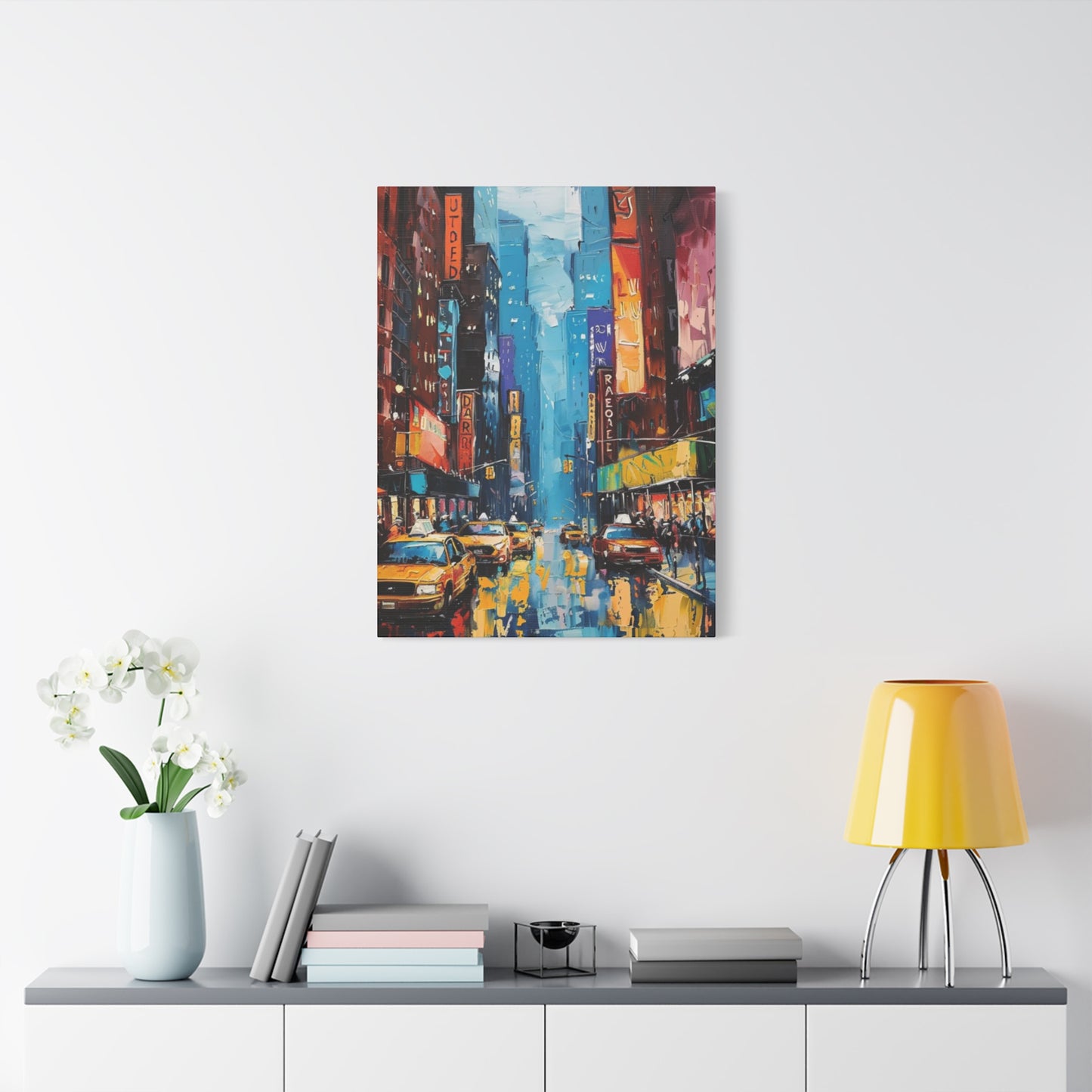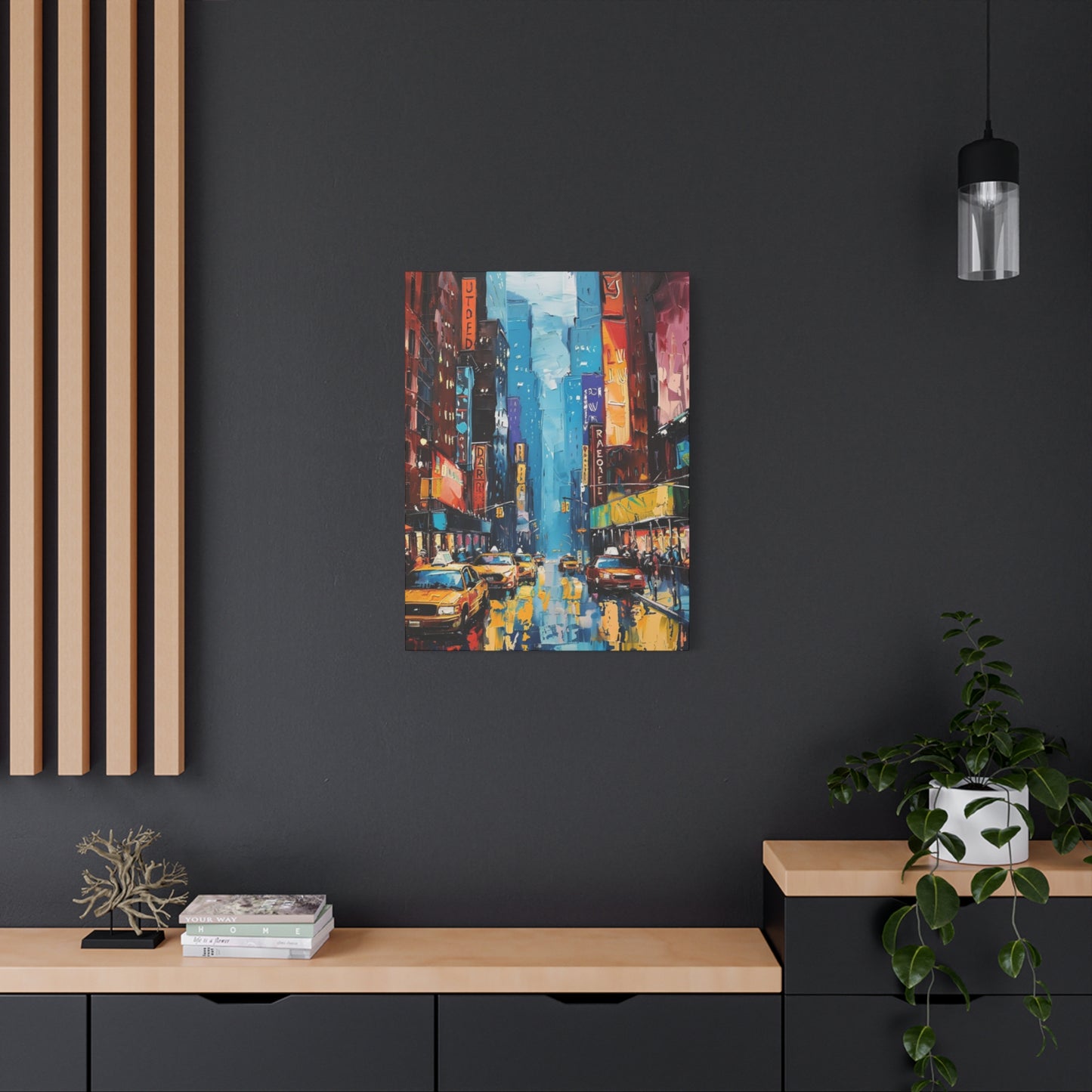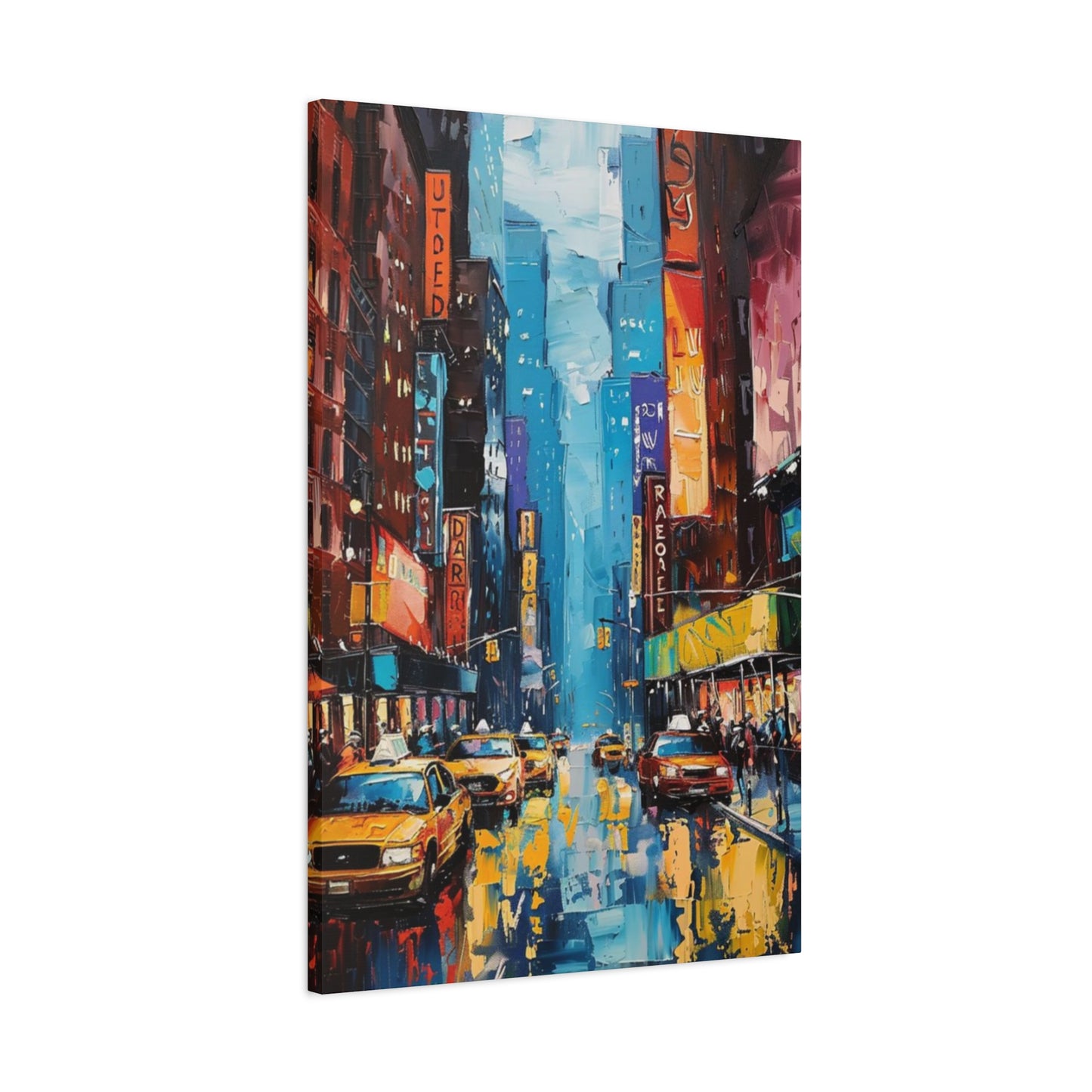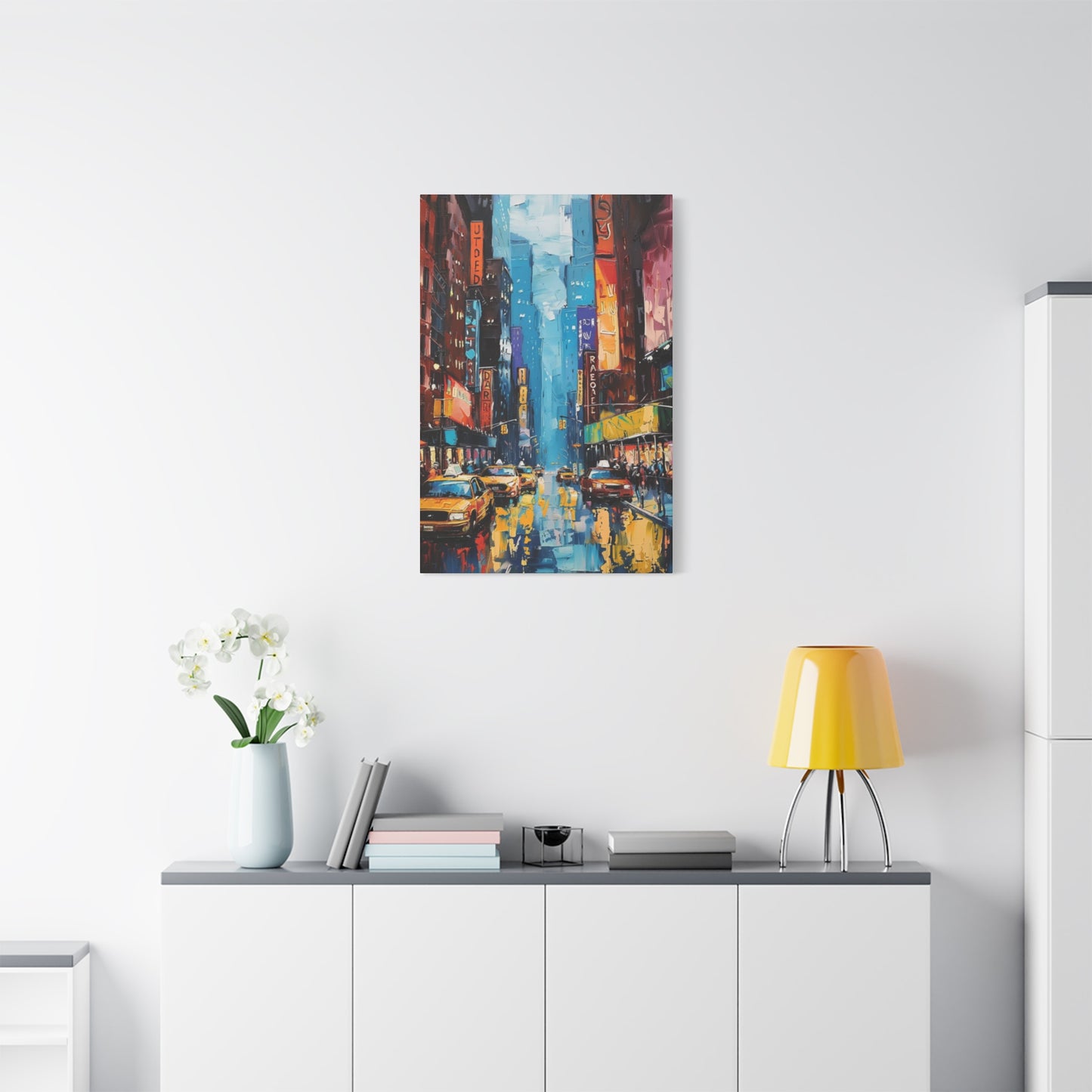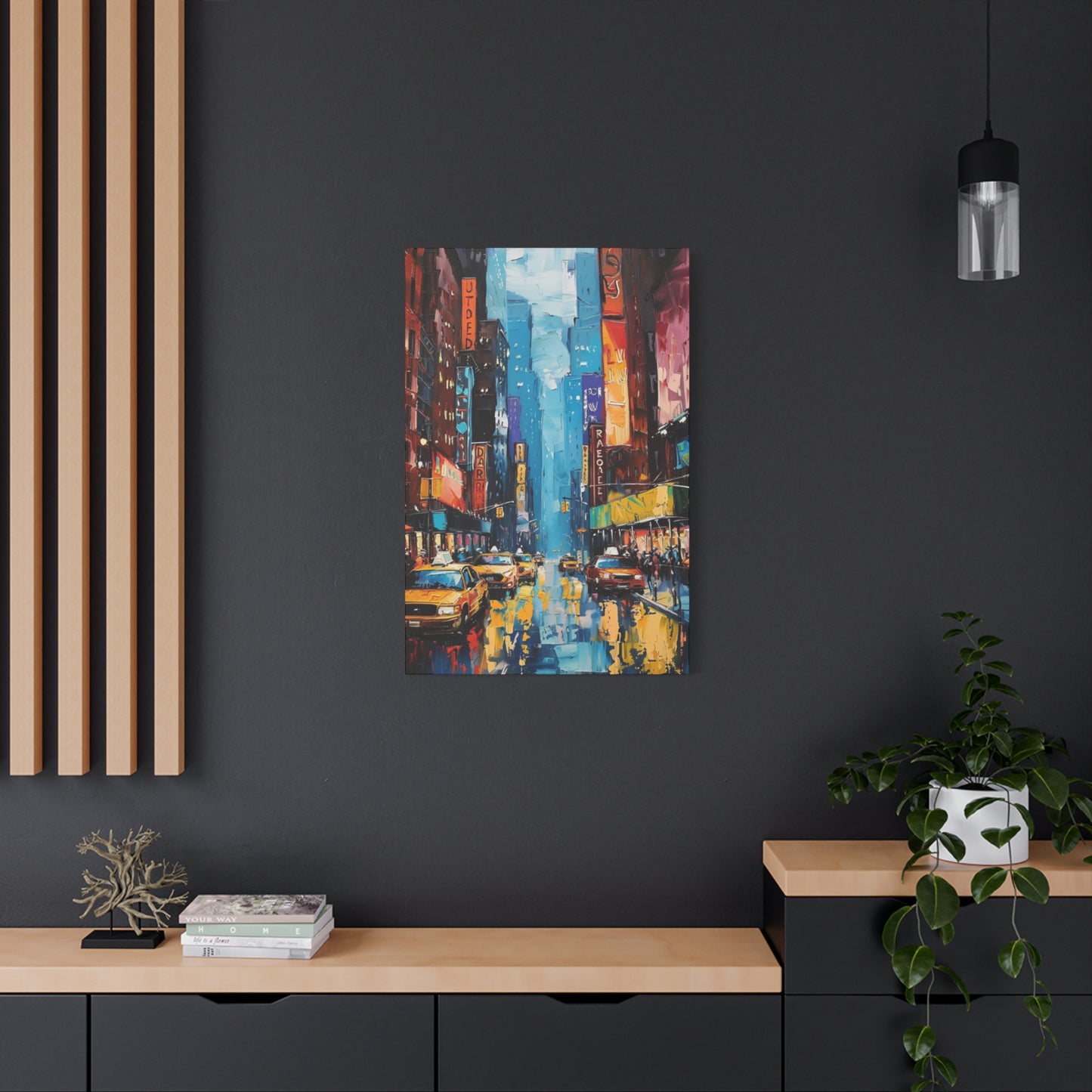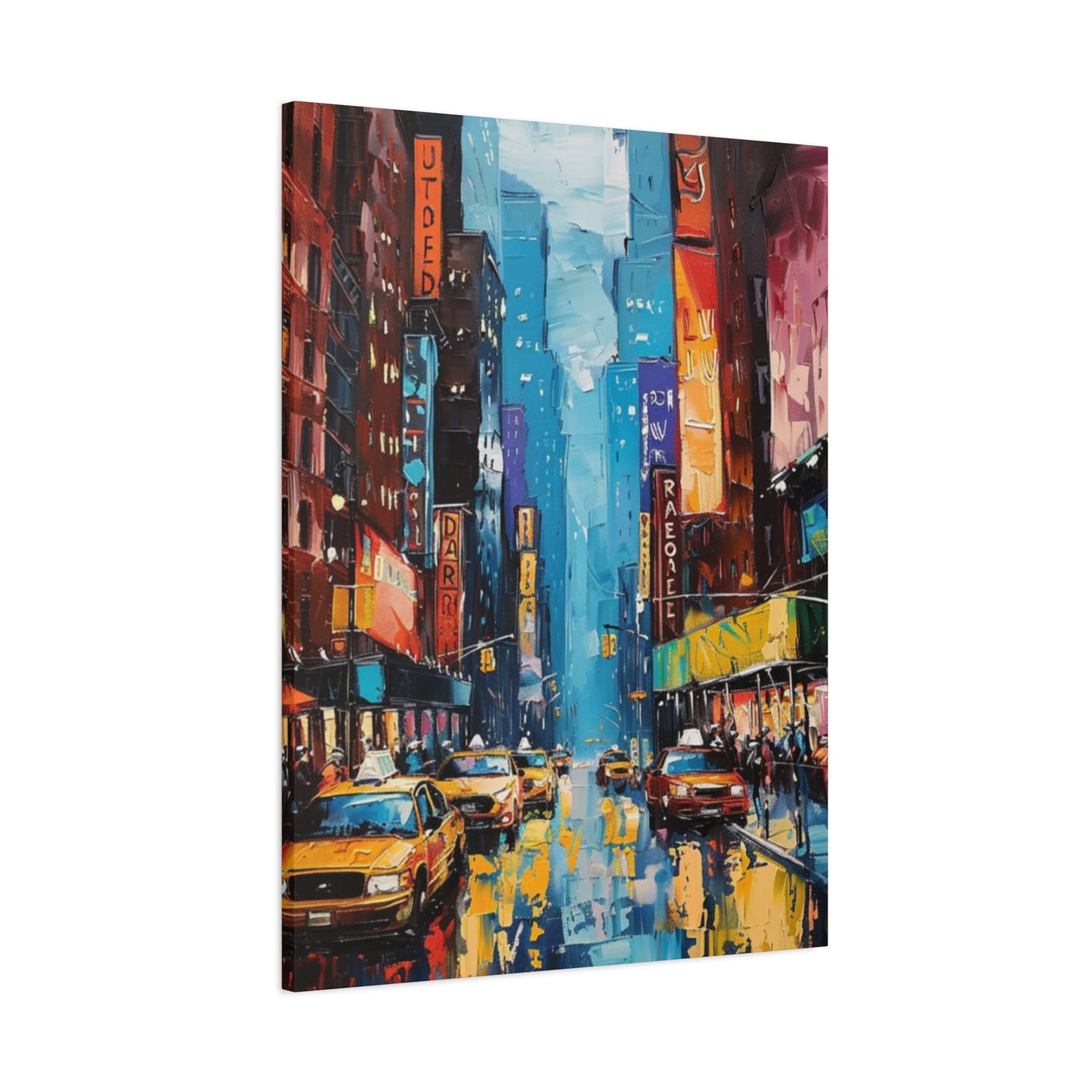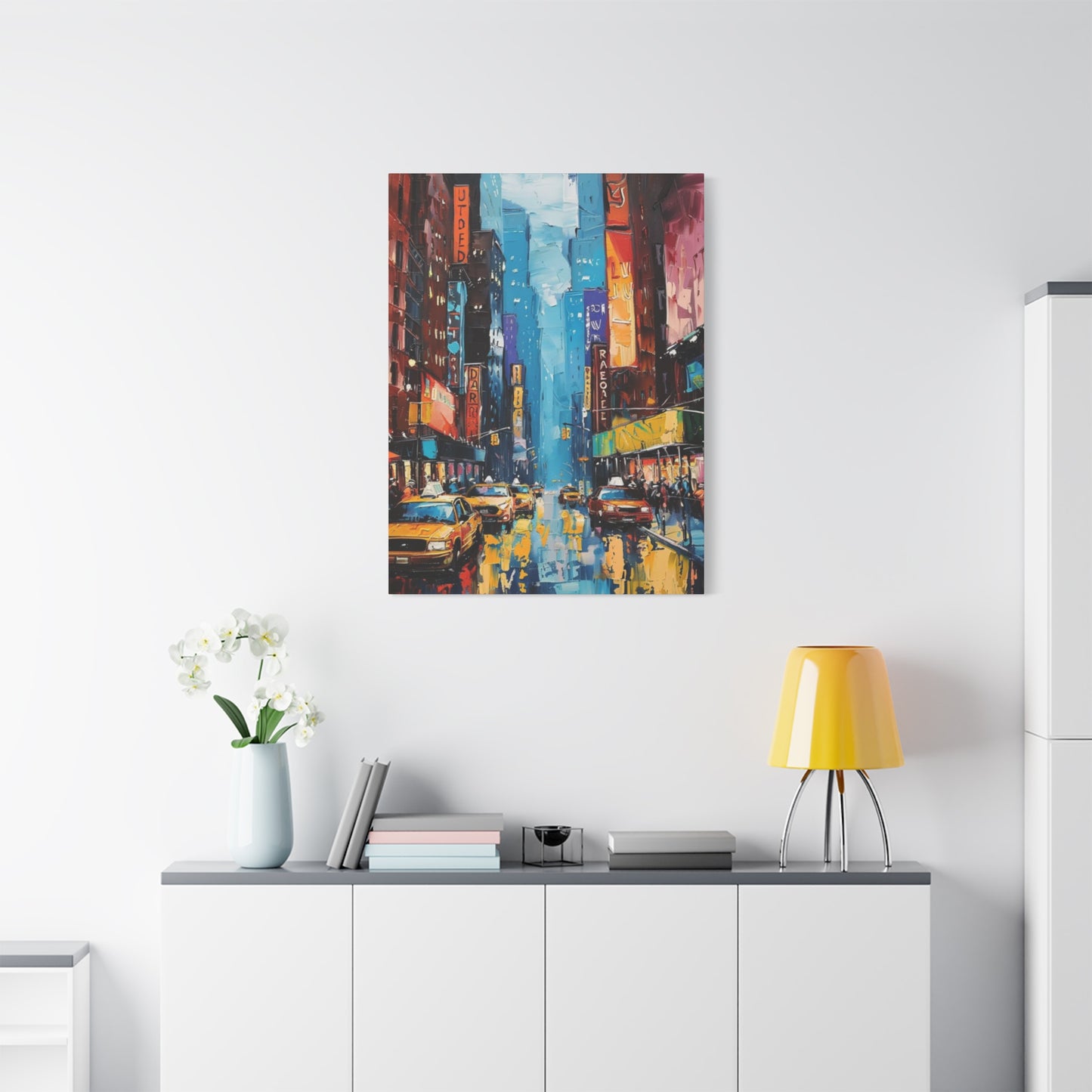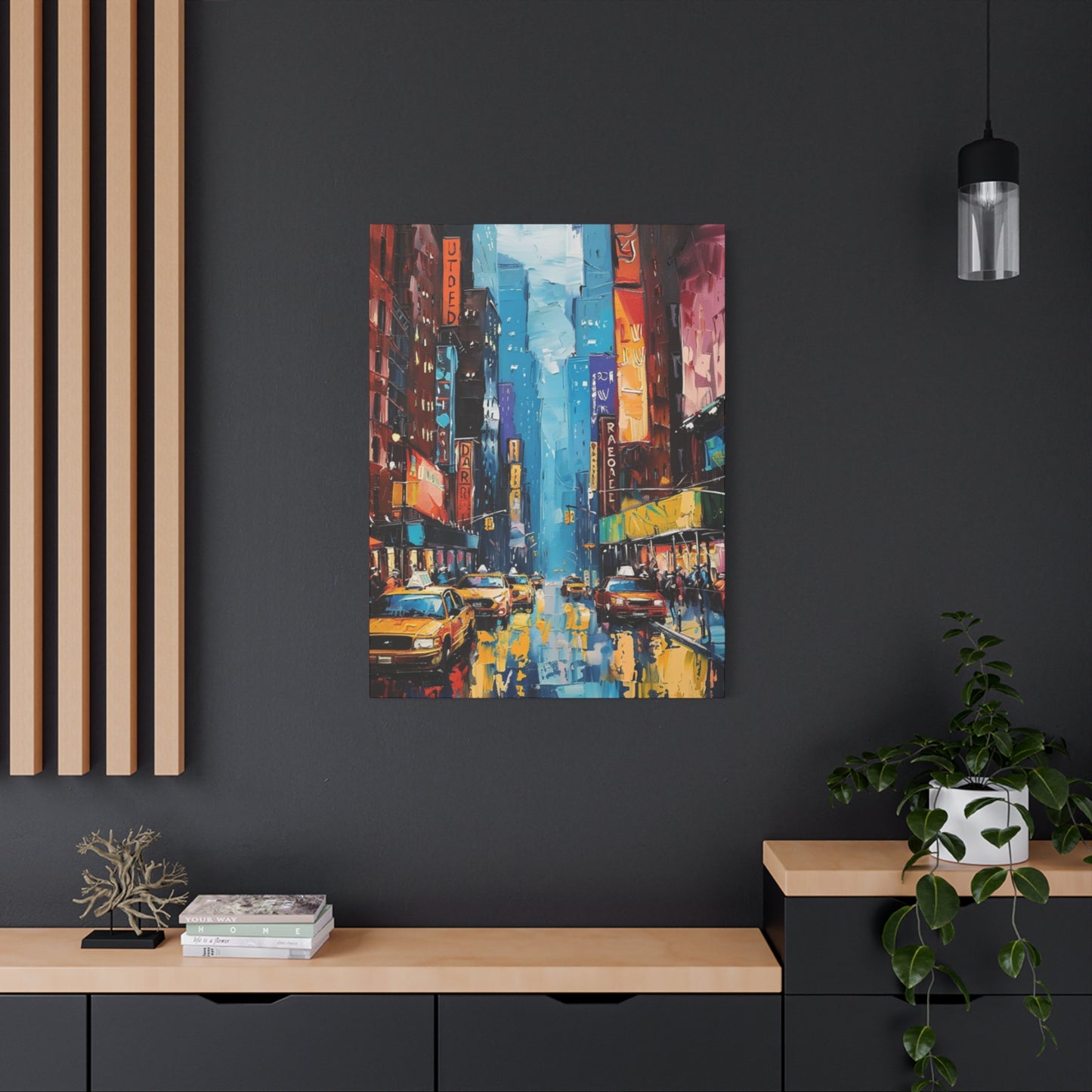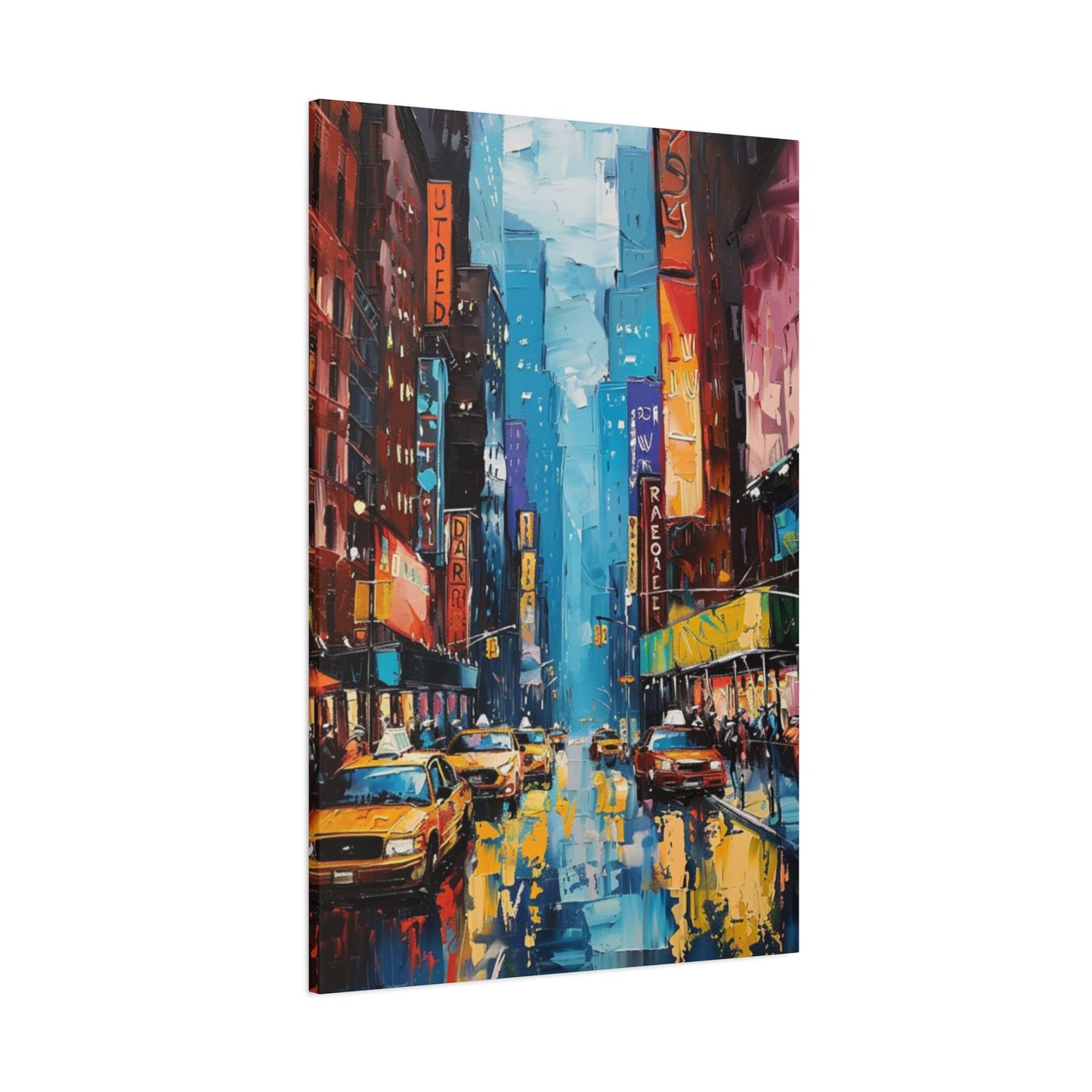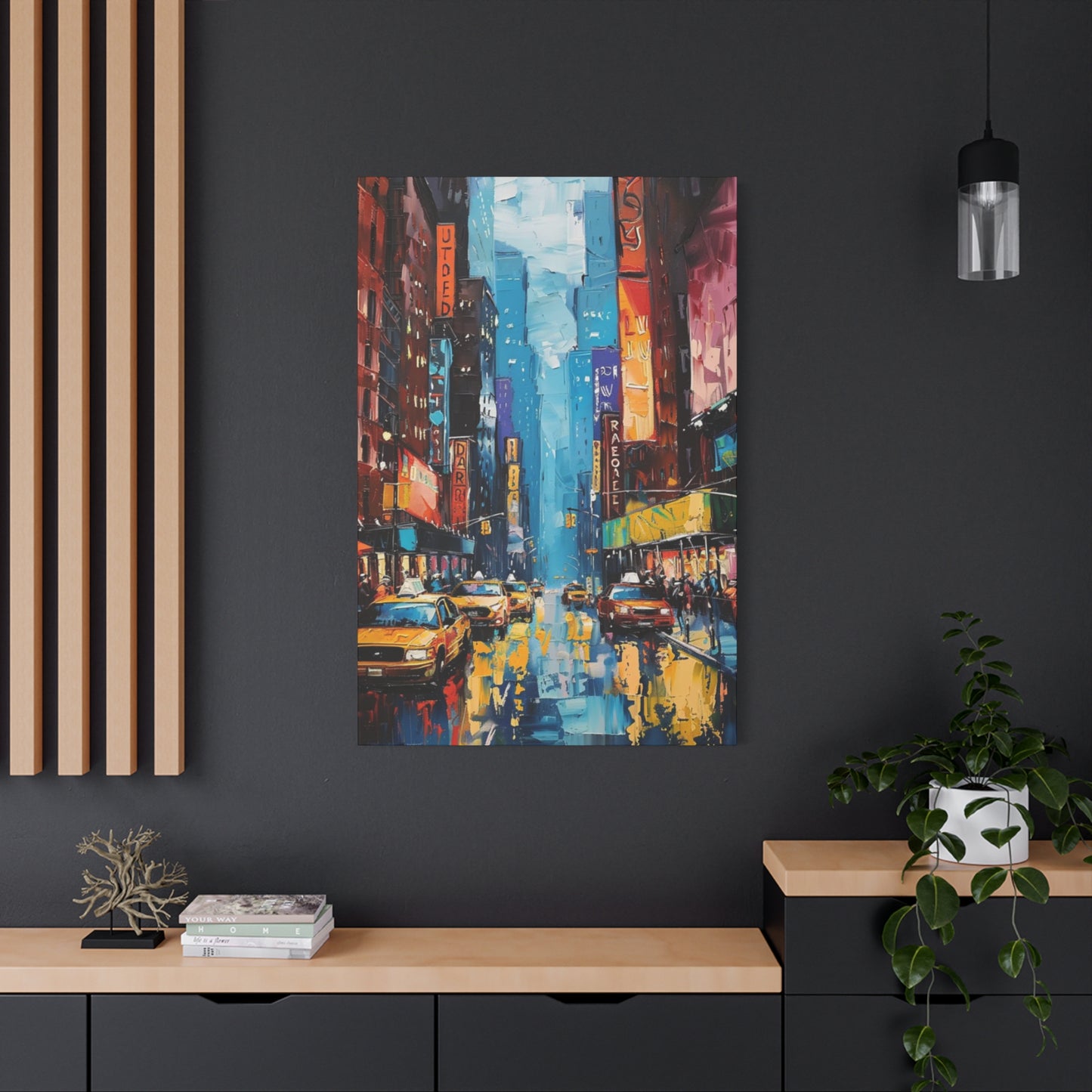Rainy NYC Skyline Wall Art: Capturing the City's Dramatic Beauty in Every Brushstroke
The magnetism of New York City reaches its peak when rain transforms the urban landscape into a shimmering canvas of reflected lights and atmospheric drama. Rainy NYC skyline wall art has emerged as one of the most sought-after artistic expressions, capturing the raw emotion and cinematic beauty that emerges when precipitation meets the concrete jungle. This artistic movement celebrates the unique character that rain brings to the Big Apple, transforming ordinary street scenes into extraordinary visual narratives that speak to both residents and admirers worldwide.
When precipitation blankets the city, something magical happens to the metropolitan landscape. The usual hustle and bustle takes on a different rhythm, while neon signs and streetlights create mesmerizing reflections on wet pavement. Artists have long recognized this transformation, using their creative vision to immortalize these fleeting moments of urban poetry. The result is a genre of artwork that captures not just the physical appearance of the city during rainfall, but the emotional resonance that these scenes evoke in viewers.
The appeal of rainy NYC skyline wall art extends far beyond mere aesthetic appreciation. These pieces serve as windows into the soul of the city, revealing the vulnerability and beauty that exists beneath the hard exterior of urban life. They remind us that even the most bustling metropolis can be transformed by natural elements, creating moments of introspection and wonder amidst the chaos of daily life.
Capturing NYC's Rainy Streets in Wall Art
The art of documenting rain-soaked streets in the Big Apple requires a unique perspective and understanding of urban dynamics. Artists who specialize in this genre possess an innate ability to recognize the transformative power of precipitation on city landscapes. They understand that rain doesn't simply add moisture to the environment; it fundamentally alters the visual, emotional, and atmospheric qualities of every scene it touches.
Professional artists often spend countless hours observing how different weather conditions affect the same location. A busy intersection that appears ordinary on a sunny day becomes a symphony of reflected colors and movement when rain begins to fall. The wet asphalt acts as a mirror, doubling the visual impact of every neon sign, traffic light, and illuminated storefront. This natural phenomenon creates layers of depth and complexity that skilled artists capture through various mediums and techniques.
The technical aspects of creating authentic rainy street art involve understanding how light behaves in wet conditions. Water droplets on surfaces create unique refractive effects, while puddles become natural mirrors that reflect the surrounding environment. Artists must master the subtle gradations of light and shadow that occur when artificial illumination interacts with moisture-laden air. The result is artwork that doesn't just depict rain, but actually makes viewers feel the atmosphere of being present during a downpour.
Color theory plays a crucial role in effective rainy street art. The muted tones that naturally occur during overcast conditions require careful balance to maintain visual interest while remaining true to the atmospheric conditions. Many artists develop signature palettes that capture the essence of rain-soaked streets, often incorporating deeper blues, grays, and purples that naturally dominate during precipitation. However, the strategic use of warmer tones from artificial lighting creates striking contrasts that draw the eye and create focal points within the composition.
The human element in rainy street scenes adds another layer of storytelling to the artwork. Figures hurrying along sidewalks with umbrellas, couples sharing shelter under building overhangs, or solitary individuals contemplating the storm all contribute to the narrative quality of these pieces. Artists often study pedestrian behavior during different weather conditions to accurately capture the body language and movement patterns that are unique to rainy days.
Seasonal variations in rainy street scenes provide artists with diverse inspiration throughout the year. Spring showers create different atmospheric conditions than autumn storms, while winter precipitation might include snow mixed with rain, creating entirely different visual opportunities. Each season brings its own color palette, lighting conditions, and emotional associations that skilled artists incorporate into their work.
Moody Vibes: Rainy New York City Skyline Art
The atmospheric qualities that define rainy NYC skyline art extend far beyond simple weather documentation. These pieces capture the profound emotional resonance that emerges when one of the world's most dynamic cities becomes shrouded in precipitation and cloud cover. The resulting artwork evokes feelings of contemplation, romance, mystery, and urban solitude that resonate deeply with viewers from all walks of life.
Atmospheric perspective becomes particularly pronounced in rainy skyline compositions. Buildings that normally stand in sharp relief against clear skies become softened and ethereal when viewed through rain and mist. This natural filtering effect creates layers of depth that artists use to guide the viewer's eye through the composition. Foreground elements remain crisp and detailed, while background structures fade into atmospheric haze, creating a sense of infinite depth and scale.
The emotional impact of moody rainy skyline art stems from its ability to capture transitional moments in urban life. These aren't the bright, optimistic scenes typically associated with travel photography or promotional materials. Instead, they reveal the contemplative side of city living, the moments when residents and visitors alike are forced to slow down and experience the metropolis at a different pace.
Professional artists working in this genre often develop techniques for capturing the subtle color variations that occur during different types of precipitation. A light drizzle creates different atmospheric conditions than a heavy downpour, and artists must understand these distinctions to create authentic representations. The way light diffuses through water-laden air affects every aspect of color temperature and saturation, requiring sophisticated understanding of both meteorology and color theory.
The architectural elements of the NYC skyline take on different characteristics when viewed through rain and atmospheric moisture. Iconic buildings like the Empire State Building or One World Trade Center become mysterious silhouettes when partially obscured by low-hanging clouds. This transformation from familiar landmark to mysterious form allows artists to present well-known structures in completely new contexts, creating fresh perspectives on familiar scenes.
Lighting conditions during rainy periods create unique opportunities for dramatic contrast in skyline compositions. The interplay between artificial illumination from buildings and the natural diffusion caused by atmospheric moisture produces lighting scenarios that simply don't exist during clear weather. Windows become beacons of warmth against the cool tones of the storm, while street-level lighting creates pools of illumination that pierce through the atmospheric haze.
The temporal aspects of rainy skyline art add another dimension to these compositions. Unlike clear-weather scenes that can appear static, rainy skylines are inherently dynamic. Clouds move, precipitation varies in intensity, and lighting conditions change rapidly. Artists must capture not just a single moment, but the sense of ongoing transformation that defines these atmospheric conditions.
Why Rainy NYC Skyline Art Is So Popular
The widespread appeal of rainy NYC skyline art stems from multiple psychological, aesthetic, and cultural factors that resonate with diverse audiences. This artistic genre taps into fundamental human responses to weather, urban environments, and the interplay between natural and man-made elements. The popularity of these pieces reflects deeper cultural associations with rain, cities, and the romantic notion of urban solitude.
Psychological research has demonstrated that many people find the sound and sight of rain inherently calming and contemplative. When this natural phenomenon is combined with the dynamic energy of one of the world's most famous cities, the result is artwork that satisfies both the desire for tranquility and the excitement of urban life. Rainy NYC skyline art provides viewers with a safe way to experience the drama and atmosphere of stormy weather without the physical discomfort.
The cinematic quality of rainy urban scenes has been reinforced by decades of film and television productions set in New York City. Many iconic movie moments have featured rain-soaked streets and atmospheric skylines, creating cultural associations between precipitation and dramatic storytelling. These media representations have trained audiences to associate rainy NYC scenes with romance, mystery, and emotional depth, making artwork in this genre immediately recognizable and emotionally resonant.
From a purely aesthetic standpoint, rainy skyline art offers visual complexity that appeals to sophisticated viewers. The interplay of light and shadow, the reflection effects created by wet surfaces, and the atmospheric depth achieved through natural diffusion create multi-layered compositions that reward careful examination. Unlike simpler artistic subjects, these pieces offer new details and relationships with each viewing, maintaining long-term interest and engagement.
The collectible nature of NYC-themed art adds another dimension to the popularity of rainy skyline pieces. Art collectors often seek works that capture unique perspectives on familiar subjects, and rain provides that distinctive angle on one of the world's most photographed and painted cities. These pieces offer collectors the opportunity to own representations of NYC that stand apart from more conventional sunny-day depictions.
The emotional accessibility of rainy scenes makes this artwork appealing to both casual art appreciators and serious collectors. While abstract or highly conceptual art might require specialized knowledge to fully appreciate, the immediate emotional impact of a well-executed rainy skyline piece is accessible to virtually any viewer. This broad appeal makes these works suitable for both private collections and public display.
The nostalgic qualities inherent in rainy city scenes contribute significantly to their popularity. Many viewers associate rain with childhood memories, quiet moments of reflection, or romantic encounters. When these personal associations are combined with the iconic status of the NYC skyline, the resulting artwork becomes a powerful trigger for emotional memory and personal connection.
Market trends in contemporary art have shown increasing interest in works that combine realistic representation with emotional depth. Rainy NYC skyline art satisfies this demand by offering technically skilled depictions of recognizable subjects while maintaining strong atmospheric and emotional content. This combination appeals to collectors who want artwork that demonstrates artistic skill while also providing ongoing aesthetic and emotional satisfaction.
Best Styles for Rainy NYC Street Wall Art
The diversity of artistic styles available for rainy NYC street wall art reflects the flexibility and universal appeal of this subject matter. From photorealistic paintings that capture every droplet and reflection to impressionistic interpretations that emphasize mood and atmosphere over precise detail, artists working in this genre have developed numerous approaches to represent the unique beauty of rain-soaked urban scenes.
Photorealistic techniques have gained significant popularity among artists specializing in rainy street scenes. These works require exceptional technical skill and attention to detail, as artists must accurately represent complex reflection patterns, water droplet formations, and the subtle ways that light behaves in moisture-laden environments. The resulting pieces often possess an almost magical quality, as viewers are amazed by the artist's ability to capture such ephemeral effects with permanent media.
Impressionistic approaches to rainy street art emphasize emotional impact over precise representation. These works use loose brushwork, strategic color placement, and atmospheric effects to suggest rather than explicitly depict the experience of being in rain-soaked city streets. This style allows artists greater freedom to interpret the emotional content of their subjects while still maintaining recognizable urban elements.
Contemporary digital art techniques have opened new possibilities for creating rainy street scenes. Digital artists can layer multiple elements, experiment with lighting effects, and achieve atmospheric results that might be difficult or impossible with traditional media. The flexibility of digital tools allows for extensive experimentation with color, texture, and composition while maintaining the ability to make precise adjustments throughout the creative process.
Mixed media approaches combine various materials and techniques to create rich, textural representations of rainy streets. These works might incorporate traditional painting with collage elements, metallic accents, or even three-dimensional components that add physical depth to the representation of wet surfaces and atmospheric effects. The tactile qualities of mixed media pieces can enhance the sensory impact of viewing rainy scene artwork.
Abstract interpretations of rainy NYC streets focus on capturing the essential emotional and atmospheric qualities rather than literal representation. These works might use flowing forms, color gradients, and gestural marks to convey the movement and energy of precipitation without depicting specific architectural or street-level details. Abstract approaches allow viewers to project their own experiences and associations onto the artwork.
Minimalist styles strip rainy street scenes down to essential elements, using simple compositions and limited color palettes to create powerful emotional impact. These works often focus on single architectural elements, isolated figures, or dramatic lighting effects to create concentrated visual and emotional experiences. The restraint inherent in minimalist approaches can actually enhance the atmospheric impact of rainy scene artwork.
Traditional watercolor techniques are particularly well-suited to rainy street scenes, as the fluid nature of the medium naturally suggests the flow and transparency of water. Skilled watercolorists can achieve atmospheric effects that perfectly capture the misty, ethereal qualities of rain-soaked urban environments. The unpredictability of watercolor also adds an element of spontaneity that mirrors the changeable nature of weather itself.
Adding Drama with Rainy NYC Skyline Prints
The inherent drama of rainy NYC skyline scenes provides artists and collectors with powerful visual narratives that command attention in any environment. These prints capture moments of natural theatre, where atmospheric conditions transform the familiar urban landscape into something extraordinary and emotionally charged. The dramatic potential of these scenes lies not just in their visual impact, but in their ability to suggest larger stories about human experience in urban environments.
Dramatic lighting effects are perhaps the most compelling aspect of rainy skyline prints. The interaction between artificial illumination and natural atmospheric conditions creates lighting scenarios that simply don't exist during clear weather. Storm clouds can act as natural diffusers, creating soft, even illumination that makes building lights glow with unusual intensity. Alternatively, breaks in cloud cover can create dramatic spotlighting effects, where individual buildings or city sections are illuminated while others remain in shadow.
The temporal drama captured in these prints reflects the dynamic nature of weather systems over urban areas. Unlike static sunny-day scenes, rainy skyline images suggest ongoing change and movement. Viewers can almost sense the wind pushing clouds across the sky, the varying intensity of precipitation, and the changing light conditions that make each moment unique. This sense of captured time adds narrative depth to what might otherwise be simple architectural documentation.
Color drama in rainy skyline prints often involves sophisticated relationships between warm artificial lighting and cool natural tones. The golden or orange light from building windows creates striking contrasts against the blue-gray tones of storm clouds and rain-darkened surfaces. This color tension adds visual energy to compositions while also suggesting the emotional contrast between indoor warmth and outdoor storm conditions.
The scale relationships in rainy NYC skyline prints contribute significantly to their dramatic impact. Towering skyscrapers disappearing into low-hanging clouds emphasize the immense vertical scale of the city while suggesting the power of natural forces to obscure even the most monumental human constructions. This interplay between human achievement and natural phenomena creates visual and conceptual drama that resonates with viewers on multiple levels.
Atmospheric perspective becomes particularly dramatic in rainy skyline compositions, where multiple layers of depth are created through varying degrees of atmospheric obscuration. Buildings in the foreground remain clearly defined, while those in the middle distance become softer and more ethereal, and background structures might be completely obscured by rain and mist. This natural layering effect creates compositions with extraordinary depth and visual complexity.
The emotional drama of rainy skyline prints often stems from their ability to capture the solitary aspects of urban life. These scenes frequently convey a sense of isolation and contemplation that contrasts sharply with the typical associations of NYC as a crowded, energetic metropolis. This emotional complexity makes these prints particularly engaging for viewers who appreciate artwork that operates on multiple psychological levels.
Print quality becomes crucial when reproducing the subtle tonal variations and atmospheric effects that define dramatic rainy skyline images. High-quality reproduction techniques must be capable of capturing the full range of tonal values from the deepest shadows in storm clouds to the brightest highlights from illuminated building windows. The printing process itself becomes part of the artistic expression, requiring careful attention to color accuracy and tonal reproduction.
How Rainy Street Scenes Change NYC Art
The introduction of rainy street scenes has fundamentally altered the landscape of NYC-themed artwork, expanding the emotional and aesthetic range of urban artistic expression. This evolution has challenged traditional approaches to city documentation and opened new avenues for artistic interpretation of metropolitan life. The influence of rain as an artistic element has transformed not just individual artworks, but entire approaches to understanding and representing urban experience.
Historical context reveals that early NYC art often focused on the architectural grandeur and human energy of the city during favorable weather conditions. Traditional approaches emphasized the monumental aspects of urban construction and the bustling activity of street life during clear conditions. The integration of rainy scenes has introduced elements of vulnerability, introspection, and natural beauty that were previously underexplored in metropolitan artwork.
The technical challenges posed by rainy street scenes have pushed artists to develop new skills and techniques for capturing complex atmospheric effects. Traditional approaches to urban art often relied on sharp contrasts and clear definition of architectural elements. Rain introduces softness, reflection, and atmospheric diffusion that require different artistic approaches. This technical evolution has enriched the overall vocabulary of urban artistic expression.
Conceptual shifts in NYC art have accompanied the technical evolution brought about by rainy scene documentation. Artists have begun to explore themes of transience, weather dependency, and the relationship between natural and artificial environments in ways that weren't prominent in earlier urban art. These conceptual developments have added philosophical depth to what was often primarily documentary or celebratory artistic expression.
The market response to rainy NYC street scenes has demonstrated significant collector interest in artwork that presents familiar subjects from fresh perspectives. This commercial success has encouraged more artists to explore weather-related themes and atmospheric conditions in their urban artwork. The economic validation of these approaches has contributed to their artistic legitimacy and continued development.
Gallery presentation of rainy street scenes often requires different curatorial approaches than traditional urban art. The atmospheric and emotional qualities of these works benefit from presentation strategies that emphasize their contemplative aspects rather than their documentary functions. This has influenced broader trends in how urban art is displayed and contextualized in gallery settings.
Educational institutions teaching urban art have incorporated rain scene techniques into their curricula as standard elements of metropolitan artistic training. Students learning to depict city life now routinely study atmospheric perspective, reflection effects, and the color theory specific to wet conditions. This educational integration ensures that future generations of urban artists will continue to develop and refine these approaches.
The influence of rainy street scenes has extended beyond NYC-specific artwork to affect how artists approach urban subjects in general. Cities worldwide are being depicted with greater attention to atmospheric conditions and weather-related aesthetic opportunities. This global influence demonstrates the universal appeal and artistic value of rain-enhanced urban scenes.
Using Rainy NYC Skyline Art in Home Decor
The integration of rainy NYC skyline art into residential environments requires careful consideration of both aesthetic impact and emotional atmosphere. These pieces bring unique qualities to home decor that differ significantly from traditional landscape or abstract artwork. The moody, atmospheric nature of rainy skyline pieces can transform living areas by introducing elements of urban sophistication while maintaining the contemplative qualities that make these scenes so appealing.
Room selection plays a crucial role in maximizing the impact of rainy skyline artwork. Living rooms and formal dining areas often benefit from the dramatic presence of large-scale rainy skyline pieces, which serve as conversation starters and focal points. The sophisticated urban content makes these works particularly suitable for entertaining areas where guests can appreciate both the technical skill and emotional depth of the artwork.
Bedrooms present unique opportunities for rainy skyline art placement, as the contemplative and calming qualities of these scenes can contribute to restful environments. The muted color palettes typical of rainy scenes often complement bedroom color schemes while providing visual interest without overwhelming stimulation. Many collectors find that rainy NYC artwork in bedrooms creates a sense of cosmopolitan romance that enhances the intimate atmosphere of these private areas.
Home office environments often benefit significantly from rainy NYC skyline art, as these pieces can provide inspiration and visual relief during work periods. The urban energy contained within atmospheric compositions can stimulate creativity while the contemplative qualities promote focus and concentration. The sophisticated nature of cityscape art also enhances the professional atmosphere of home working environments.
Lighting considerations become particularly important when displaying rainy skyline artwork, as the atmospheric effects depicted in these pieces can be enhanced or diminished by artificial illumination choices. Warm, directional lighting often complements the golden tones from building windows depicted in rainy scenes, while cooler lighting can emphasize the atmospheric blues and grays of storm conditions. Some collectors install adjustable lighting systems that allow them to modify the presentation based on time of day or desired mood.
Framing selections for rainy NYC skyline art should complement both the artwork itself and the surrounding decor while respecting the atmospheric nature of the subject matter. Simple, elegant frames often work best, as ornate framing can compete with the complex atmospheric effects within the artwork. Many collectors choose frames in neutral tones that allow the artwork's color palette to dominate while providing subtle enhancement of the overall presentation.
Scale relationships between artwork and furniture require careful planning when incorporating rainy skyline pieces into home environments. These atmospheric works often benefit from generous display areas that allow viewers to fully experience their immersive qualities. Cramped placement can diminish the sense of urban scale and atmospheric depth that makes these pieces so compelling.
Color coordination with existing decor elements provides opportunities to create sophisticated design relationships that enhance both the artwork and the surrounding environment. The typical color palette of rainy NYC scenes includes sophisticated blues, grays, and warm accent tones that can be echoed in furniture, textiles, and accessory choices throughout the room.
The Story Behind Rainy NYC Street Paintings
The artistic tradition of documenting rain-soaked NYC streets carries rich historical significance that connects contemporary artists with generations of urban observers and chroniclers. These paintings represent more than aesthetic achievements; they serve as cultural documents that preserve specific moments in the city's ongoing evolution while capturing the timeless human experience of navigating urban environments during atmospheric disturbances.
Early examples of rainy NYC street paintings often emerged from artists' personal experiences of dramatic weather events that transformed familiar city scenes into extraordinary visual phenomena. Many significant works in this genre originated from artists who found themselves caught in unexpected downpours and became fascinated by the transformation of ordinary street corners into cinematic scenes of urban drama. These spontaneous encounters with atmospheric beauty often inspired entire series of related works.
The development of painting techniques specific to rain-soaked urban scenes required artists to observe and understand meteorological phenomena in sophisticated ways. Successful rain scene painters often spend considerable time studying how different types of precipitation affect urban surfaces, how artificial lighting interacts with water droplets in the air, and how atmospheric conditions modify color perception. This scientific approach to atmospheric observation enhances the authenticity and emotional impact of the resulting artwork.
Personal narratives often drive the creation of memorable rainy street paintings, as artists draw upon their own experiences of significant moments that occurred during NYC rainstorms. Proposals, chance encounters, moments of solitude, or professional achievements that happened to coincide with dramatic weather become woven into artistic interpretations of those atmospheric conditions. These personal connections add depth and authenticity to paintings that might otherwise remain purely observational.
Technical innovation in rain scene painting often results from artists' attempts to solve specific representational challenges posed by wet urban environments. The development of techniques for depicting convincing reflection patterns, atmospheric perspective effects, and the complex interplay of natural and artificial lighting has pushed many artists to experiment with new materials, application methods, and compositional approaches.
Cultural documentation aspects of rainy NYC street paintings provide valuable records of how the city has changed over time. Comparative examination of rain scene paintings created in different decades reveals evolution in architectural details, street furniture, vehicle types, clothing styles, and urban infrastructure. These paintings serve as atmospheric time capsules that preserve not just weather conditions, but the broader cultural context of specific historical moments.
The collaborative nature of some rainy street painting projects involves artists working together to capture different aspects of the same atmospheric conditions. Some artists specialize in architectural elements, others focus on human figures, and still others concentrate on atmospheric effects. These collaborative approaches can result in comprehensive artistic documentation of specific weather events that no single artist could achieve independently.
Contemporary relevance of historical rainy street paintings often increases over time as urban development changes the physical appearance of depicted locations. Paintings that document rain-soaked streets in areas that have since undergone significant redevelopment become valuable historical records of lost urban landscapes. This documentary value adds another dimension to the aesthetic and emotional appeal of these works.
Tips for Choosing Rainy NYC Skyline Wall Art
Selecting appropriate rainy NYC skyline wall art requires consideration of multiple factors that affect both immediate visual impact and long-term satisfaction with the artwork. The unique characteristics of atmospheric urban scenes present specific challenges and opportunities that differ from more conventional artistic subjects. Successful selection involves balancing aesthetic preferences with practical considerations such as display location, budget constraints, and personal emotional responses to different atmospheric presentations.
Authenticity assessment becomes particularly important when evaluating rainy NYC skyline artwork, as the popularity of this genre has led to the proliferation of works that may lack the technical skill or emotional depth that characterizes the best examples. Genuine artistic achievement in this area requires sophisticated understanding of both urban architecture and atmospheric effects, combined with technical execution that can convincingly represent complex visual phenomena.
Scale considerations play a crucial role in selecting rainy skyline artwork that will function effectively in intended display locations. Large-scale pieces can create immersive experiences that transport viewers into the atmospheric conditions depicted, while smaller works might serve better as intimate focal points or components of larger display arrangements. The intended viewing distance and surrounding architectural elements should influence scale decisions.
Color palette analysis helps ensure that selected artwork will integrate successfully with existing decor while maintaining its own visual integrity. Rainy NYC skyline pieces typically feature sophisticated color relationships between cool atmospheric tones and warm artificial lighting, but specific works may emphasize different aspects of this color spectrum. Understanding these variations helps buyers select pieces that will enhance rather than conflict with their environment.
Emotional resonance testing involves spending time with potential purchases to assess their ongoing appeal and psychological impact. The most successful rainy skyline artwork selections often involve pieces that create strong initial emotional responses while also revealing additional details and relationships through extended viewing. This depth of content helps ensure long-term satisfaction with significant art investments.
Technical quality evaluation requires understanding the specific challenges involved in creating convincing rainy urban scenes. Effective works must demonstrate mastery of atmospheric perspective, reflection effects, color temperature relationships, and the complex interplay between natural and artificial lighting. Buyers should look for evidence of sophisticated technical execution rather than merely attractive initial impressions.
Artist reputation research helps buyers understand the broader context of specific works within artists' careers and the genre as a whole. Established artists working in rainy NYC scenes often have developed signature approaches or technical innovations that add value and interest to their work. Understanding these artistic contributions can enhance both the intellectual and financial value of art purchases.
Investment potential analysis involves considering both the current market position and future prospects for rainy NYC skyline artwork. The growing popularity of this genre suggests continued collector interest, while the technical difficulty of creating high-quality examples may limit supply. These market factors can influence the investment characteristics of specific purchases.
Iconic NYC Landmarks in Rainy Weather Art
The transformation of recognizable NYC landmarks through atmospheric conditions provides artists with opportunities to present familiar structures in completely new contexts. Rainy weather fundamentally alters the appearance and emotional impact of iconic buildings, creating artistic opportunities that reveal different aspects of these well-known architectural achievements. The interplay between instantly recognizable forms and dramatic atmospheric conditions produces artwork that satisfies both familiarity and novelty.
The Empire State Building serves as perhaps the most frequent subject for rainy weather artwork, as its Art Deco profile becomes particularly dramatic when partially obscured by low-hanging clouds or atmospheric haze. Artists working with this landmark often focus on the way its illuminated upper floors pierce through storm conditions, creating beacon-like effects that emphasize both the building's monumental scale and its role as a navigational reference point within the urban landscape.
One World Trade Center presents unique opportunities for rain scene artwork due to its contemporary design and symbolic significance. The building's crystalline form interacts with atmospheric conditions in ways that differ from older NYC architecture, creating reflection patterns and light diffusion effects that contemporary artists can exploit for both aesthetic and conceptual purposes. The emotional weight of this location adds another layer of meaning to atmospheric interpretations.
Brooklyn Bridge artwork often benefits from rainy conditions that soften the structure's Gothic details while emphasizing its sculptural qualities against stormy skies. The bridge's stone towers become mysterious silhouettes when viewed through rain and mist, while the suspended cables create linear elements that artists can use to guide viewer attention through atmospheric compositions. The bridge's role as a connection between boroughs gains additional metaphorical weight when depicted during storms.
Central Park landmarks take on entirely different characteristics when depicted during rainy conditions, as the natural elements of the park interact with precipitation in ways that complement and contrast with surrounding urban development. The Bethesda Fountain, Bow Bridge, and other park features become focal points for artwork that explores the relationship between natural and constructed environments within the urban context.
Times Square presents particular challenges and opportunities for rainy weather artwork due to its intense artificial illumination and constant activity. Rain in this environment creates extraordinary reflection effects as neon and LED lighting interacts with wet pavement and atmospheric moisture. Artists working with Times Square rain scenes often focus on the way commercial lighting transforms precipitation into a medium for color and movement.
The Chrysler Building's distinctive Art Deco crown becomes particularly photogenic during atmospheric conditions that emphasize its metallic surfaces and geometric details. Rain and mist often create dramatic backlighting effects that highlight the building's architectural ornament while creating mystery around its lower floors. This landmark's relatively modest height compared to newer skyscrapers allows it to be completely visible even during low cloud conditions.
Statue of Liberty artwork benefits from the maritime atmospheric conditions that frequently affect New York Harbor. Rain scenes featuring this landmark often incorporate the nautical elements of fog, mist, and atmospheric perspective that enhance the statue's symbolic significance as a beacon of hope and freedom. The island setting provides opportunities for dramatic compositions that emphasize both isolation and prominence.
Combining Rainy Street Art with City Skyline
The artistic integration of street-level rain scenes with broader skyline views requires sophisticated compositional planning that successfully combines multiple scales and perspectives within unified artistic statements. This approach allows artists to present comprehensive views of urban rain experiences that include both intimate human-scale details and grand architectural context. The resulting works offer viewers complex visual narratives that operate simultaneously on multiple levels of urban experience.
Perspective management becomes crucial when combining street and skyline elements within single compositions. Artists must establish clear spatial relationships that allow viewers to understand the geographic and scale connections between foreground street activity and background architectural elements. This often involves using atmospheric perspective techniques that gradually reduce detail and clarity as compositions move from street level to skyline elements.
Compositional balance requires careful attention to visual weight distribution when incorporating both detailed street scenes and broad skyline views. Street-level elements often provide compositional anchors and human interest, while skyline components contribute scale and urban context. Successful combinations maintain viewer interest at both levels while creating unified artistic statements that don't fragment into separate, competing visual areas.
Lighting consistency across different scales presents technical challenges that test artists' understanding of how atmospheric conditions affect illumination at various distances. Street-level lighting sources must relate logically to the broader atmospheric conditions depicted in skyline portions of compositions. This requires sophisticated understanding of how precipitation affects light transmission and reflection at different scales within urban environments.
Narrative coherence helps ensure that combined street and skyline compositions tell unified stories rather than simply presenting two different urban views within the same frame. Effective combinations often suggest causal relationships between street-level activity and broader atmospheric conditions, or they present different temporal moments of the same weather event from multiple perspectives.
Technical execution of combined compositions often requires mastery of different artistic approaches within single works. Street-level details might demand precise representational techniques, while skyline elements could benefit from more impressionistic approaches that emphasize atmospheric effects over architectural specifics. Artists working in this mode must seamlessly integrate these different technical approaches.
Color harmony across multiple scales requires understanding how atmospheric conditions affect color temperature and saturation at different distances within urban environments. Street-level colors often remain more saturated and warm, while skyline elements become cooler and more muted due to atmospheric interference. Managing these natural color transitions contributes to the overall credibility and visual appeal of combined compositions.
Market appeal of combined street and skyline compositions often exceeds that of works focusing exclusively on single scales, as these pieces offer viewers more comprehensive urban experiences. Collectors appreciate artwork that provides multiple points of interest and different types of visual engagement, making combined compositions valuable additions to both private collections and public displays.
Black and White Rainy NYC Skyline Art Ideas
Monochromatic approaches to rainy NYC skyline art offer unique aesthetic opportunities that emphasize tonal relationships, compositional structure, and emotional content over color-based visual appeal. Black and white rain scene artwork often achieves greater dramatic impact through its reliance on light, shadow, and atmospheric effects rather than color variation. This artistic approach connects contemporary urban art with the rich tradition of monochromatic photography and printmaking that has long documented city life.
Tonal range exploration becomes the primary tool for creating visual interest and emotional impact in black and white rainy skyline compositions. Artists working in monochrome must master subtle gradations between pure white and absolute black, using the full spectrum of gray tones to create atmospheric depth and architectural definition. The absence of color forces greater attention to these tonal relationships, often resulting in more sophisticated understanding of light and shadow effects.
Contrast management takes on heightened importance in black and white rain scenes, as dramatic lighting effects become the primary means of creating focal points and guiding viewer attention through compositions. The interplay between illuminated building windows and dark storm clouds creates natural contrast opportunities that artists can enhance or moderate based on desired emotional impact. High contrast approaches create dramatic, film noir-like atmospheres, while subtle tonal variations produce more contemplative, introspective effects.
Texture emphasis becomes more prominent in monochromatic rain scenes, as viewers' attention naturally focuses on surface qualities when color is absent. Rain creates numerous textural opportunities through its effects on different urban surfaces, from smooth glass and metal to rough concrete and asphalt. Black and white reproduction often enhances these textural contrasts, making them more apparent than they might be in color versions of the same scenes.
Historical reference points for black and white urban rain scenes include the work of prominent street photographers and printmakers who documented city life throughout the twentieth century. Contemporary artists working in this tradition can draw upon established visual languages while applying them to current urban conditions. This historical connection adds cultural depth to black and white rain scene artwork while demonstrating continuity with established artistic traditions.
Print medium considerations become particularly important for black and white rainy skyline artwork, as the reproduction method significantly affects tonal reproduction and overall visual impact. Traditional silver gelatin prints offer different aesthetic qualities than contemporary digital reproductions, while various printmaking techniques like etching or lithography provide additional creative possibilities for monochromatic urban scenes.
Emotional interpretation often differs between color and black and white versions of similar rainy urban scenes. Monochromatic presentations tend to emphasize universal human experiences over specific temporal or cultural markers that color might provide. This universality can make black and white rain scenes more timeless and emotionally accessible to diverse audiences.
Contemporary relevance of black and white rainy NYC artwork connects with ongoing interest in analog aesthetic approaches and documentary photography traditions. Many collectors specifically seek monochromatic work as alternatives to the color saturation that dominates contemporary visual culture. Black and white rain scenes provide sophisticated visual experiences that stand apart from typical contemporary artistic approaches.
Brightening Rooms with Rainy NYC Street Art
The apparent contradiction between brightening living environments and incorporating artwork that depicts stormy weather conditions actually reveals sophisticated opportunities for enhancing home atmospheres through strategic art selection and presentation. Rainy NYC street art can contribute significantly to room brightness through its frequent incorporation of warm artificial lighting, reflective surfaces, and dramatic contrast effects that create visual energy even within atmospheric compositions.
Light reflection principles that appear in rainy street artwork can be leveraged to enhance actual room illumination when pieces are strategically positioned relative to light sources. Artwork featuring wet pavement reflections, illuminated storefronts, and glowing streetlights often contains bright elements that catch and reflect ambient room lighting. This creates a feedback effect where the artwork appears to contribute to room brightness while actually reflecting existing illumination.
Color temperature considerations play important roles in how rainy street art affects perceived room brightness. While storm scenes naturally feature cooler color temperatures from overcast skies and atmospheric conditions, the artificial lighting elements within these compositions often provide warm color accents that create psychological associations with comfort and brightness. The contrast between cool and warm elements can make warm tones appear particularly intense and inviting.
Artwork placement strategies can maximize the brightening effects of rainy street scenes by positioning pieces where they will benefit from natural and artificial lighting while reflecting illumination back into room areas. Placement opposite windows allows artwork to benefit from natural light during daytime hours, while strategic relationship to artificial lighting sources can create dramatic evening presentation that contributes to overall room brightness.
Frame selection and matting choices significantly influence how rainy street artwork affects room brightness. Light-colored or metallic frames can enhance reflective qualities while drawing additional attention to bright elements within artwork compositions. Wide, light-colored mats can create bright borders that make artwork appear to emit light while creating visual breathing room that prevents atmospheric compositions from feeling oppressive.
Conclusion
Rainy NYC skyline wall art captures more than just a cityscape—it encapsulates the soul of New York City in its most intimate and poetic form. The interplay of rain-soaked streets, glowing lights, and towering silhouettes tells a story of motion, mystery, and resilience. Every brushstroke, every reflection on wet pavement, evokes the drama and rhythm of city life, offering a timeless glimpse into the heart of a metropolis that never sleeps—even in the rain.
What sets rainy NYC skyline art apart is its ability to portray both the grandeur and the grit of the city. The soft haze of rain adds depth and emotion to architectural icons like the Empire State Building, Brooklyn Bridge, and countless rooftops lost in the mist. These scenes reflect not just the physical beauty of the city but also the moods and moments it inspires—quiet introspection, romantic walks under umbrellas, or the hopeful glow of streetlights cutting through the gray.
Stylistically, this art form is incredibly versatile. It ranges from hyper-realistic paintings and moody black-and-white photography to impressionistic interpretations with bold colors and dynamic textures. Whether you’re curating a modern loft, a cozy apartment, or an eclectic gallery wall, rainy NYC art adds sophistication, emotion, and a touch of cinematic allure to your space.
Beyond décor, this type of wall art offers something deeper—it captures the feeling of being present in the city during its quieter, more reflective moments. It’s for those who find beauty in the unexpected, who understand that even a rainy day in New York holds a kind of magic. It’s a tribute to the city’s ever-changing moods and the people who walk its streets no matter the weather.
In conclusion, rainy NYC skyline wall art is a powerful blend of atmosphere, emotion, and architectural wonder. It brings the city’s dramatic beauty into your home, not as a postcard-perfect image, but as a living, breathing experience—captured in every thoughtful brushstroke or lens flare of rain.

















